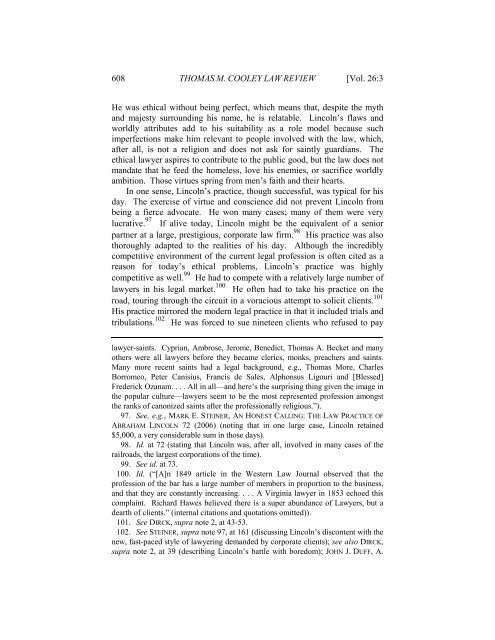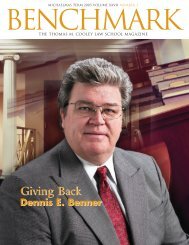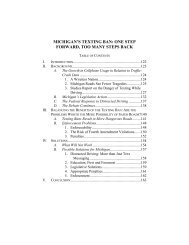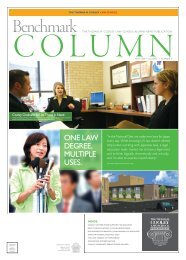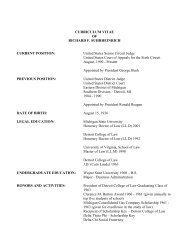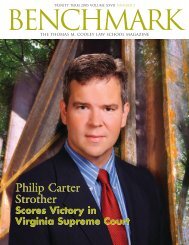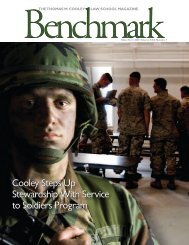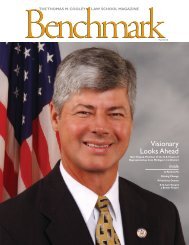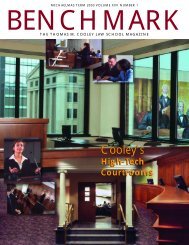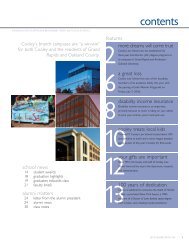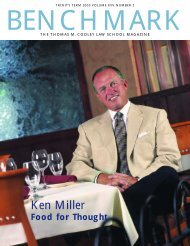Beyond The Model Rules - Thomas M. Cooley Law School
Beyond The Model Rules - Thomas M. Cooley Law School
Beyond The Model Rules - Thomas M. Cooley Law School
You also want an ePaper? Increase the reach of your titles
YUMPU automatically turns print PDFs into web optimized ePapers that Google loves.
608 THOMAS M. COOLEY LAW REVIEW [Vol. 26:3He was ethical without being perfect, which means that, despite the mythand majesty surrounding his name, he is relatable. Lincoln’s flaws andworldly attributes add to his suitability as a role model because suchimperfections make him relevant to people involved with the law, which,after all, is not a religion and does not ask for saintly guardians. <strong>The</strong>ethical lawyer aspires to contribute to the public good, but the law does notmandate that he feed the homeless, love his enemies, or sacrifice worldlyambition. Those virtues spring from men’s faith and their hearts.In one sense, Lincoln’s practice, though successful, was typical for hisday. <strong>The</strong> exercise of virtue and conscience did not prevent Lincoln frombeing a fierce advocate. He won many cases; many of them were verylucrative. 97 If alive today, Lincoln might be the equivalent of a seniorpartner at a large, prestigious, corporate law firm. 98 His practice was alsothoroughly adapted to the realities of his day. Although the incrediblycompetitive environment of the current legal profession is often cited as areason for today’s ethical problems, Lincoln’s practice was highlycompetitive as well. 99 He had to compete with a relatively large number oflawyers in his legal market. 100 He often had to take his practice on theroad, touring through the circuit in a voracious attempt to solicit clients. 101His practice mirrored the modern legal practice in that it included trials andtribulations. 102 He was forced to sue nineteen clients who refused to paylawyer-saints. Cyprian, Ambrose, Jerome, Benedict, <strong>Thomas</strong> A. Becket and manyothers were all lawyers before they became clerics, monks, preachers and saints.Many more recent saints had a legal background, e.g., <strong>Thomas</strong> More, CharlesBorromeo, Peter Canisius, Francis de Sales, Alphonsus Ligouri and [Blessed]Frederick Ozanam. . . . All in all—and here’s the surprising thing given the image inthe popular culture—lawyers seem to be the most represented profession amongstthe ranks of canonized saints after the professionally religious.”).97. See, e.g., MARK E. STEINER, AN HONEST CALLING: THE LAW PRACTICE OFABRAHAM LINCOLN 72 (2006) (noting that in one large case, Lincoln retained$5,000, a very considerable sum in those days).98. Id. at 72 (stating that Lincoln was, after all, involved in many cases of therailroads, the largest corporations of the time).99. See id. at 73.100. Id. (“[A]n 1849 article in the Western <strong>Law</strong> Journal observed that theprofession of the bar has a large number of members in proportion to the business,and that they are constantly increasing. . . . A Virginia lawyer in 1853 echoed thiscomplaint. Richard Hawes believed there is a super abundance of <strong>Law</strong>yers, but adearth of clients.” (internal citations and quotations omitted)).101. See DIRCK, supra note 2, at 43-53.102. See STEINER, supra note 97, at 161 (discussing Lincoln’s discontent with thenew, fast-paced style of lawyering demanded by corporate clients); see also DIRCK,supra note 2, at 39 (describing Lincoln’s battle with boredom); JOHN J. DUFF, A.


